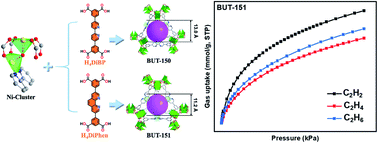Two isostructural metal–organic frameworks with unique nickel clusters for C2H2/C2H6/C2H4 mixture separation†
Abstract
Novel metal clusters and coordinatively unsaturated sites are important features of metal–organic frameworks (MOFs) for many applications such as catalysis, gas storage and separation. Herein, two isostructural MOFs, BUT-150 and BUT-151 with unprecedented binuclear nickel clusters have been developed, using tetracarboxylate linkers containing chelating bipyridine-type units. The nickel cluster is coordinated with four carboxylate groups, one bipyridine unit, and one bridging water, leading to two open nickel sites per cluster. Interestingly, the two MOFs show selective adsorption of C2H2 and C2H6 over C2H4, representing two rare examples of MOFs with open metal sites for such ternary separation. Especially, BUT-151 with a phenanthroline unit has a high C2H2/C2H4 selectivity of 2.31 and C2H6/C2H4 selectivity of 1.36 at 273 K, being higher or comparable to current benchmark materials. The overall good separation performance of BUT-151 may be attributed to its high acetylene affinity from open metal sites and efficient confinement of ethane molecules by the open window with rich oxygen sites. Column breakthrough experiments confirm the good separation performance of binary or ternary gas mixtures by BUT-151 under dynamic conditions.



 Please wait while we load your content...
Please wait while we load your content...